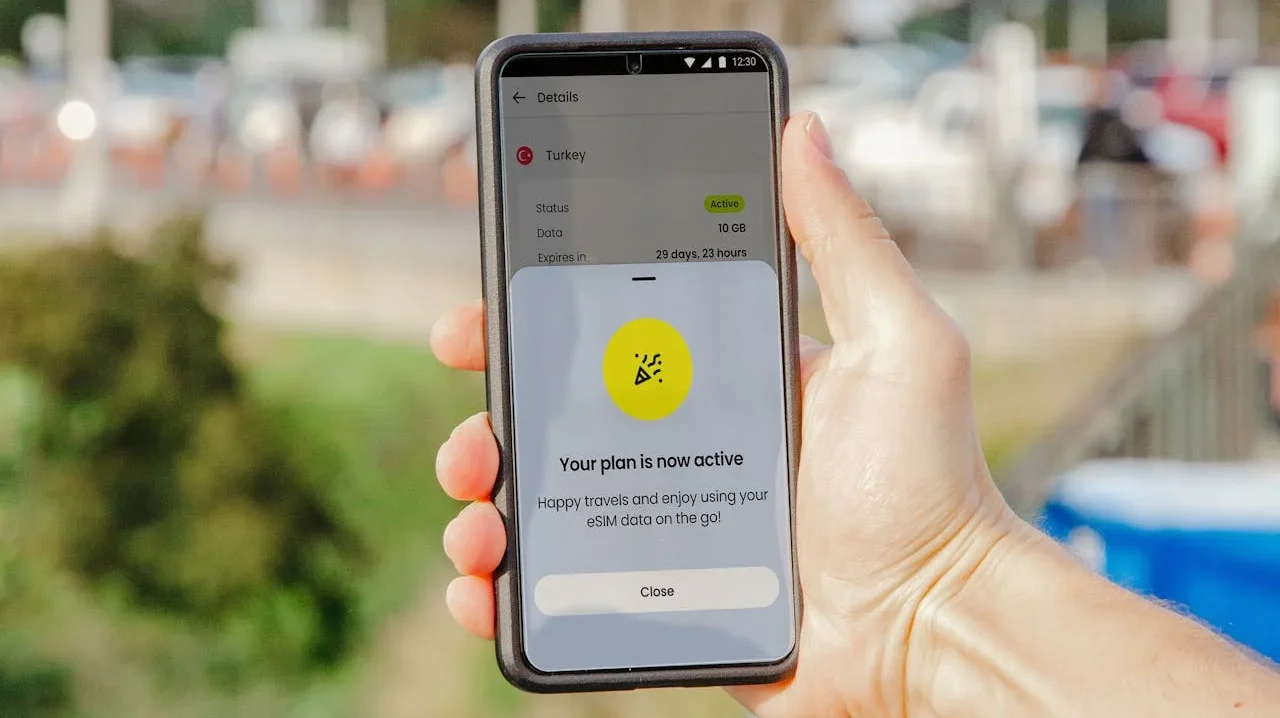Key Takeaways
The main advantages of an eSIM:
The main drawbacks of an eSIM
The SIM Card
The physical version of the SIM card is something you probably know already and it is an acronym for “Subscriber Identity Module”. It’s a piece of plastic with a gold plate which just slots into your phone.
Evolution of SIM Cards
SIM cards used to be much bigger than we see today with more plastic surrounding the gold plate.
As technology evolved and smartphone manufacturers became more and more obsessed with creating more space in their phones to have larger screens, batteries and more, the plastic around the SIM card was cut down to the bare minimum.
This now leaves us with what we have today, the micro SIM which is just big enough to house the gold chip.

Importance of SIM Cards
What a SIM Card Does
Why is this mini piece of gold and plastic so important? A SIM card holds data called the International Mobile Subscriber Identity Number or IMSI, and its related key which are used to identify and authenticate subscribers on mobile telephone devices.
In simple terms, a SIM lets a mobile network provider know whether or not your phone can be used on its network.
In most places, there are cell towers around with many mobile providers. They need to verify if your phone is allowed on their network and link this identity to your phone plan, which includes the amount of data, text, and talk time you’ve subscribed to.
Switching Networks with SIM Cards
Let’s say you are going on holiday abroad, say you’re flying to Dubai in the United Arab Emirates. If you want to use your phone there without paying international roaming you’d get a SIM card from a local provider like Etisalat or Du.
You’d just swap out the physical SIM in your phone from your home network provider with another physical SIM card of your destination.
The main drawback here is that you have to make sure that you don’t lose your original SIM card, otherwise, when you initially return home, you’d have no service and you’d have to contact your network provider to get a new one.
Major Advantage of Physical SIM Cards
Despite the drawback of having to take care of a physical card, the major advantage of a physical SIM card is that they keep the data on a card rather than hard wiring it on your phone
For those of you who are old enough to remember phones before SIM cards, if you were traveling internationally with your phone, you wouldn’t be able to just use your phone in some other country because all that identification data was tied to the phone itself.
With SIM cards, all you have to do is swap out the card and put in another card, whether it’s a local network abroad or just another network in your home country, you’re ready to go within seconds.
Introduction of the eSIM: What is an eSIM?
The short and non-technical answer is, an eSIM is a digital SIM card that is embedded directly into a device allowing you to activate and switch plans without swapping out a physical SIM.
Now for the nerdy answer, in 2016, what’s known as the Universal Integrated Circuit Card or the “UICC” that is embedded in the physical SIM cards was standardized into the e-sim which uses an eUICC chip that’s hardwired onto newer phones.
Most of the smartphones manufactured in the last few years all have an eUICC chip which make them e-sim compatible
It gives you a lot of flexibility because if you want to switch mobile networks either at home or when you’re traveling, you don’t need to swap a physical SIM card.
Instead, you just install an eSIM using an eSIM provider or directly from a network provider. Most mobile network service providers around the world nowadays offer some type of eSIM.

Benefits of eSIM for Travel
Skip the Queues
eSIMs are incredibly useful when you’re traveling to another country. As a frequent flier myself, I can’t tell you how convenient it is to land in a country and be connected straight away.
You avoid the scenario where you would be queuing up at a kiosk, then swapping out your physical SIM card and then storing your home SIM card somewhere safe.
Connect Instantly Around the World
It’s also pretty handy to connect the moment you land rather than waiting until you pass through immigration or connect to WiFi, especially as some airport WiFi connections are not great so you can’t connect straight away.
To obtain an eSIM, you just have to scan a QR code or download an app like Airalo to your phone, pay just a little money and then your eSIM is configured and ready.
You can also install multiple eSIM on your phone and activate or deactivate them as needed. Overall it’s a lot faster and more efficient.
Enhanced Security
An added benefit of using an eSIM is they are much more secure. They use an advanced level of encryption and authentication protocols which reduce the risk of hacking.
You also minimize your reliance on using public WiFi which is prone to having your sensitive data monitored by hackers.
If your phone is lost or stolen, which can happen while abroad, no one can remove your eSIM the way a physical SIM can be removed which makes it more complicated for thieves to exploit.
Since eSIMs also require some level of authorisation to be disabled, a stolen phone with an activated eSIM package is easily traceable.
Of course, this doesn’t mean eSIMs are completely impossible to clone or manipulate, but it makes it harder for thieves and hackers since they have to jump through more hoops to achieve their goal.
The eSIM Installation Process
The process of installing an eSIM has become a lot easier over the last few years.
Up until recently when they became more standardized, there were a few steps in between that made it a little bit difficult. You needed multiple devices to be able to set up but now it’s as simple as scanning a QR code or downloading an app on your phone, purchasing your plan and activating it.
The general instructions on how to install an eSIM on your device is outlined below. This is just indicative so be sure to check the instructions for your specific device.
Installing eSIM on an Android
Settings > Network & Internet > Add or + icon next to Mobile Network
Installing eSIM on iOs
Settings > Cellular > Set Up Cellular or Add eSIM > Use QR Code
The Rise of eSIM Providers
Now you also have a lot of eSIM operators and plenty of eSIM apps you can download.
This is mainly down to the fact that the costs are generally low since the providers don’t have to put physical offices in all the countries they operate in.
It’s now all digital and even the mani mobile providers are rolling out ways to port your physical SIM card over to a digital version.
Usually, the process is going to their website, logging in and scanning a QR code. Once you’re done, you no longer have to worry about keeping or losing a physical SIM card.
I personally use Airalo as they make the whole process of buying and activating an eSIM easy and simple.
Using Multiple eSIMs
As mentioned, you can install multiple eSIMS and activate them as needed. Of course, you can’t use more than one primary eSIM at a time, but you can easily switch between them as required.
This could not only be useful internationally but also domestically. For example, if you’re in an area where a network provider has poor service, you can just activate another eSIM from a network provider with a better coverage to ensure you always have network coverage.
eSIM as a Replacement for Physical SIMs
Generally, most of us have become familiar with eSIMs as a short-term solution that we use when we travel internationally. You usually get a 7-day or a 30-day card you install on your phone before you travel and then you’re set to be connected as soon as you land.
However, as we move towards an even more digitized world and smartphones adopting new technology faster than ever, eSIMs soon will become the new norm. The physical SIM cards that we are all used to may start to slowly disappear.
Much like the headphone jack that’s been now phased out on most of our smartphones
The Future of eSIM
There are more eSIM providers now than ever before, and that number is only growing.
The US version of the iPhone 14s is eSIM only, so this only means that most mobile network providers all over the world, if they haven’t already, are going to be supporting eSIMs very soon.
Don’t panic just yet though! Most network providers and smartphones are probably going to continue to support physical SIM cards for the foreseeable future.
But the rise of eSIM providers and the fact that Apple have started to exclude the physical SIM tray from their phones may just indicate that this is not just a trend, but a clear indication of the future trajectory for the physical SIM card.
Disclaimer: This page contains affiliate links which means, I may earn a small commission if you make a purchase using those links at no extra cost to you. I only recommend products and services I use personally.

About the Author
Josh Cahill is an award-winning Aviation YouTuber who is reportedly one of the most-watched flight reviewers on the internet. He organised Afghanistan’s first all-female flight together with Kam Air in February 2021 on a flight from Herat to Kabul for which he received the Aviation Achievement Award. His favourite hobby? Flying exotic airlines nobody has ever heard of.

